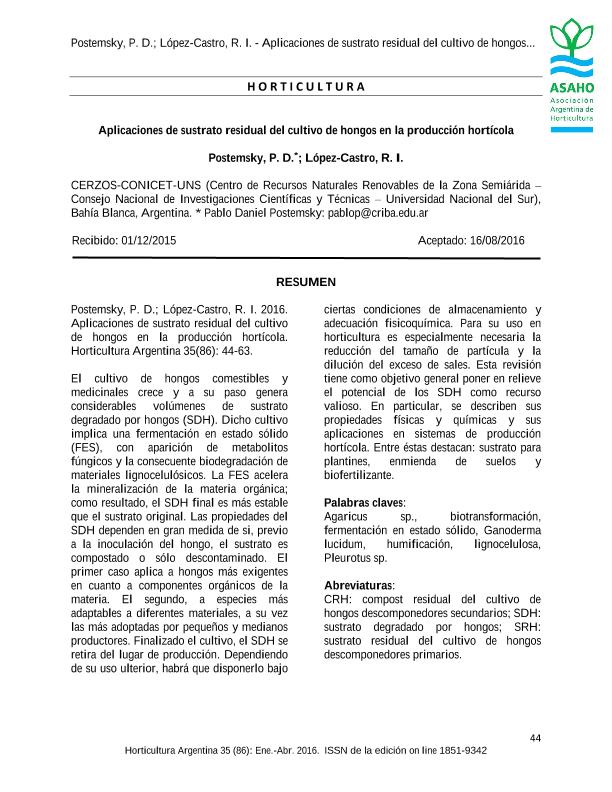Artículo
El cultivo de hongos comestibles y medicinales crece y a su paso genera considerables volúmenes de sustrato degradado por hongos (SDH). Dicho cultivo implica una fermentación en estado sólido(FES), con aparición de metabolitos fúngicos y la consecuente biodegradación de materiales lignocelulósicos. La FES acelera la mineralización de la materia orgánica; como resultado, el SDH final es más estable que el sustrato original. Las propiedades del SDH dependen en gran medida de si, previo a la inoculación del hongo, el sustrato es compostado o sólo descontaminado. El primer caso aplica a hongos más exigentes en cuanto a componentes orgánicos de la materia. El segundo, a especies más adaptables a diferentes materiales, a su vez las más adoptadas por pequeños y medianos productores. Finalizado el cultivo, el SDH se retira del lugar de producción. Dependiendo de su uso ulterior, habrá que disponerlo bajo ciertas condiciones de almacenamiento y adecuación fisico química. Para su uso en horticultura es especialmente necesaria la reducción del tamaño de partícula y la dilución del exceso de sales. Esta revisión tiene como objetivo general poner en relieve el potencial de los SDH como recurso valioso. En particular, se describen sus propiedades físicas y químicas y sus aplicaciones en sistemas de producción hortícola. Entre éstas destacan: sustrato para plantines, enmienda de suelos y biofertilizante. The cultivation of edible and medicinal mushrooms generates large volumes of substrate degraded by fungi (SDF). Mushroom cultivation implies a solid-state fermentation (SSF) with production of fungal metabolites and the consequent biodegradation of lignocellulosic materials. SSF accelerates organic matter mineralization; therefore, at the end of the cultivation cycle, SDH has greater stability than the original substrate. SDF properties depend largely on whether prior to inoculation of the mushroom species, the starting substrate is composted or just decontaminated. In the first case, the cultivated mushroom species are more substrate-sensitive. In the latter, the mushroom species used are more substrateadaptable, and are the most widely adopted by small and medium-sized producers as well. After mushroom cultivation, SDF is removed from the production site. Henceforth, depending on its further use, certain storage conditions should be observed, and physical and/or chemical conditioning is usually needed. In horticulture, particle size reduction and dilution of excess salts, by mixing with other materials or leaching, are especially required. The aim of this review is to highlight SDF’s potential as a valuable resource. Particularly, the physical and chemical properties of SDF reported in the literature are summarized, and its different uses evaluated in horticultural systems are described. Among these are: substrate for seedlings, soil amendment and biofertilizer.
Aplicaciones de sustrato residual del cultivo de hongos en la producción hortícola
Título:
Applications of mushrooms residual substrate in horticultural production
Fecha de publicación:
04/2016
Editorial:
Asociación Argentina de Horticultura
Revista:
Horticultura Argentina
ISSN:
0327-3431
e-ISSN:
1851-9342
Idioma:
Español
Tipo de recurso:
Artículo publicado
Clasificación temática:
Resumen
Palabras clave:
Fermentación en Estado Sólido
,
Compostaje
,
Humificación
,
Lignocelulosa
Archivos asociados
Licencia
Identificadores
Colecciones
Articulos(CERZOS)
Articulos de CENTRO REC.NAT.RENOVABLES DE ZONA SEMIARIDA(I)
Articulos de CENTRO REC.NAT.RENOVABLES DE ZONA SEMIARIDA(I)
Citación
Postemsky, Pablo Daniel; López Castro, Ramón Ignacio; Aplicaciones de sustrato residual del cultivo de hongos en la producción hortícola; Asociación Argentina de Horticultura; Horticultura Argentina; 35; 86; 4-2016; 44-63
Compartir




